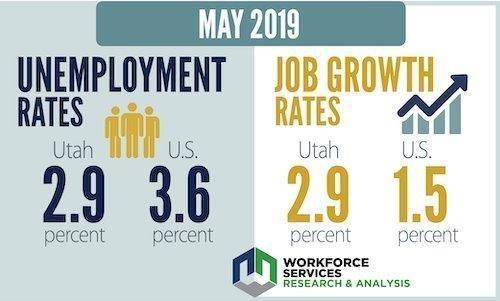Press Release
Utah’s non-farm payroll employment for May 2019 grew by an estimated 2.9 percent, adding 44,200 jobs to the economy since May 2018. Utah’s current employment level registers 1,556,400. April’s year-over job growth rate remained unrevised at 3.2 percent.
May’s seasonally adjusted unemployment rate of 2.9 percent is unchanged from April’s 2.9 percent. Approximately 45,500 Utahns were unemployed and actively seeking work during the month. The national unemployment rate was also unchanged at 3.6 percent.
“Job seeker opportunities remain robust as we continue to experience strong job growth and markedly low unemployment,” reported Mark Knold, Senior Economist at the Department of Workforce Services. “While the job growth rate did abate a bit in May, it does not reflect an underlying softening in economic demand.”
Utah’s private sector employment grew by 3.1 percent year-over with the addition of 39,200 positions. All 10 of the private sector industry groups measured in the establishment survey posted net job increases in May.
The largest private sector employment increases were in:
- Education and Health Services (7,700 jobs)
- Trade, Transportation and Utilities (6,600 jobs)
- Professional and Business Services (6,300 jobs)
The fastest employment growth occurred in:
- Information (4.7 percent)
- Manufacturing (4.7 percent)
- Education and Health Services (3.8 percent)
Following the release of the May 2019 employment numbers for the state of Utah, the U.S. Bureau of Labor Statistics (BLS) data shows Utah is ranked No. 2 for total job growth in the U.S. at 2.9 percent. In addition, Utah is ranked No. 3 for private sector job growth at 3.1 percent. For unemployment, Utah is ranked No. 8 at 2.9 percent, tied with South Dakota.
BLS data shows Utah rankings as follows:
TOTAL JOB GROWTH
(1) Nevada – 3.9 percent
(2) Utah – 2.9 percent
(3) Arizona – 2.6 percent
(3) Washington – 2.6 percent
PRIVATE SECTOR JOB GROWTH
(1) Nevada – 4.1 percent
(2) Washington – 3.3 percent
(3) Utah – 3.1 percent
UNEMPLOYMENT RATE
(1) Vermont – 2.1 percent
(2) North Dakota – 2.3 percent
(3) Iowa – 2.4 percent
(3) New Hampshire – 2.4 percent
(5) Hawaii – 2.8 percent
(5) Idaho – 2.8 percent
(5) Wisconsin – 2.8 percent
(8) Utah – 2.9 percent
(8) South Dakota – 2.9 percent
(10) Massachusetts – 3.0
(10) Nebraska – 3.0 percent
(10) Virginia – 3.0 percent

